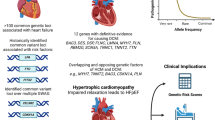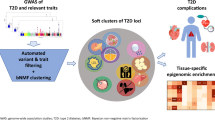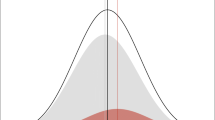Abstract
To investigate the association of myosin heavy chain protein 11 (MYH11) and transforming growth factor β signaling-related gene polymorphisms with the susceptibility of DeBakey type III aortic dissection (AD) and its clinical outcomes. Four single-nucleotide polymorphism (SNPs) (MYH11 rs115364997, rs117593370, TGFB1 rs1800469, and TGFBR1 rs1626340) were analyzed in patients with DeBakey III AD (173) and healthy participants (335). Gene–gene and gene–environment interactions were evaluated using generalized multifactor dimensionality reduction. The patients were followed up for a median of 55.7 months. MYH11 rs115364997 G or TGFBR1 rs1626340 A carriers had an increased risk of DeBakey type III AD. MYH11, TGFB1, TGFBR1, and environment interactions contributed to the risk of DeBakey type III AD (cross-validation consistency = 10/10, P = 0.001). Dominant models of MYH11 rs115364997 AG + GG genotype (HR = 2.443; 95%CI: 1.096–5.445, P = 0.029), TGFB1 rs1800469 AG + GG (HR = 2.303; 95%CI: 1.069–4.96, P = 0.033) were associated with an increased risk of mortality in DeBakey type III AD. The dominant model of TGFB1 rs1800469 AG + GG genotype was associated with an increased risk of recurrence of chest pain in DeBakey type III AD (HR = 1.566; 95%CI: 1.018–2.378, P = 0.041). In conclusions, G carriers of MYH11 rs115364997 or TGFB1 rs1800469 may be the poor prognostic indicators of mortality and recurrent chest pain in DeBakey type III AD. The interactions of gene–gene and gene–environment are associated with the risk of DeBakey type III AD.

Similar content being viewed by others
Data availability
The data that support the findings of this study are available on request from the corresponding author. The data are not publicly available due to privacy or ethical restrictions.
References
Adam B, Valentyna K, Bulat Z et al (2018) Genes associated with thoracic aortic aneurysm and dissection, an update and clinical implications. Aorta 06:013–020
Baas AF, Medic J, van’t Slot R et al (2010) Association of the TGF-beta receptor genes with abdominal aortic aneurysm. Eur J Hum Genet 18(2):240–244
Booher AM, Isselbacher EM, Nienaber CA et al (2013) The IRAD classification system for characterizing survival after aortic dissection. Am J Med 126(8):730.e19–724.e19
Bossone E, Gorla R, LaBounty TM et al (2018) Presenting systolic blood pressure and outcomes in patients with acute aortic dissection. J Am Coll Cardiol 71(13):1432–1440
De Cario R, Sticchi E, Lucarini L et al (2018) Role of TGFBR1 and TGFBR2 genetic variants in Marfan syndrome. J Vasc Surg 1:225-233.e5
Evangelista A, Isselbacher EM, Bossone E et al (2018) Insights from the international registry of acute aortic dissection: a 20-year experience of collaborative clinical research. Circulation 137(17):1846–1860
Feldo M, Kocki J, Feldo J et al (2015) CIDE-A gene expression in patients with obesity qualified for endovascular treatment of abdominal aorta aneurysm. Pol Przegl Chir 86(10):473–478
Franken R, den Hartog AW, Radonic T (2015) Beneficial outcome of losartan therapy depends on type of fbn1 mutation in marfan syndrome. Circ Cardiovasc Genet 8:383–388
Frismantiene A, Philippova M, Erne P et al (2018) Smooth muscle cell-driven vascular diseases and molecular mechanisms of VSMC plasticity. Cell Signal 52:48–64
Fujiwara T, Takeda N, Hara H et al (2018) Distinct variants affecting differential splicing of TGFBR1 exon 5 cause either Loeys-Dietz syndrome or multiple self-healing squamous epithelioma. Eur J Hum Genet 26(8):1151–1158
Gao F, Chambon P, Offermanns S et al (2014) Disruption of TGF-β signaling in smooth muscle cell prevents elastase-induced abdominal aortic aneurysm. Biochem Biophys Res Commun 1:137–143
Goumans M-J, Ten Dijke P (2018) TGF-β signaling in control of cardiovascular function. Cold Spring Harbor Perspect Biol 2:e022210
Haize G, Maria F, Reyes VM et al (2018) Characterization of carotid smooth muscle cells during phenotypic transition. Cells 3:23–25
Harakalova M, van der Smagt J, de Kovel CG et al (2013) Incomplete segregation of MYH11 variants with thoracic aortic aneurysms and dissections and patent ductus arteriosus. Eur J Hum Genet 21(5):487–493
Hipólito UV, Rocha JT, Martins-Oliveira A et al (2011) Chronic ethanol consumption reduces adrenomedullin-induced relaxation in the isolated rat aorta. Alcohol 45(8):805–814
Howard DP, Banerjee A, Fairhead JF et al (2013) Population-based study of incidence and outcome of acute aortic dissection and premorbid risk factor control: 10-year results from the Oxford Vascular Study. Circulation 127(20):2031–2037
Hu JH, Wei H, Jaffe M et al (2015) Postnatal deletion of the Type II transforming growth factor-β receptor in smooth muscle cells causes severe aortopathy in mice. Arterioscler Thromb Vasc Biol 35(12):2647–2656
Isselbacher EM, Lino Cardenas CL, Lindsay ME (2016) Hereditary influence in thoracic aortic aneurysm and dissection. Circulation 133:2516–2528
Ito S, Akutsu K, Tamori Y et al (2008) Differences in atherosclerotic profiles between patients with thoracic and abdominal aortic aneurysms. Am J Cardiol 101:696–699
Jacob AG, Smith CWJ (2017) Intron retention as a component of regulated gene expression programs. Hum Genet 136:1043–1057
Jondeau G, Ropers J, Regalado E et al (2016) International registry of patients carrying TGFBR1 or TGFBR2 mutations, results of the MAC (Montalcino Aortic Consortium). Circ Cardiovasc Genet 9(6):548–558
Karimi A, Milewicz DM (2016) Structure of the elastin-contractile units in the thoracic aorta and how genes that cause thoracic aortic aneurysms and dissections disrupt this structure. Can J Cardiol 32(1):26–34
Kim JB, Kim K, Lindsay ME et al (2015) Risk of rupture or dissection in descending thoracic aortic aneurysm. Circulation 132:1620–1629
Larson A, Rinaldo L, Brinjikji W et al (2020) Intracranial vessel stenosis in a young patient with an MYH11 mutation, a case report and review of 2 prior cases. World Neurosurg 137:243–246
Li W, Li Q, Jiao Y et al (2014) Tgfbr2 disruption in postnatal smooth muscle impairs aortic wall homeostasis. J Clin Investig 2:755–767
Loeys BL, Chen J, Neptune ER et al (2005) A syndrome of altered cardiovascular, craniofacial, neurocognitive and skeletal development caused by mutations in TGFBR1 or TGFBR2. Nat Genet 37(3):275–281
Mizuguchi T, Collod-Beroud G, Akiyama T et al (2004) Heterozygous TGFBR2 mutations in Marfan syndrome. Nat Genet 36(8):855–860
Mussa FF, Horton JD, Moridzadeh R et al (2016) Acute aortic dissection and intramural hematoma, a systematic review. JAMA 316:754–763
Norifumi T, Hironori H, Takayuki F et al (2018) TGF-β signaling-related genes and thoracic aortic aneurysms and dissections. Int J of Mol Sci 19:2125
Piechota-Polanczyk A, Jozkowicz A, Nowak W et al (2015) The abdominal aortic aneurysm and intraluminal thrombus, current concepts of development and treatment. Front Cardiovasc Med 26(2):19
Pucci L, Pointet A, Good JM et al (2020) A new variant in the MYH11 gene in a familial case of thoracic aortic aneurysm. Ann Thorac Surg 109(4):e279–e281
Renard M, Callewaert B, Baetens M et al (2013) Novel MYH11 and ACTA2 mutations reveal a role for enhanced TGFβ signaling in FTAAD. Int J Cardiol 2:314–321
Ruigrok YM, Baas AF, Medic J et al (2012) The transforming growth factor-β receptor genes and the risk of intracranial aneurysms. Int J Stroke 7(8):645–648
Takeda N, Komuro I (2019) Genetic basis of hereditary thoracic aortic aneurysms and dissections. J Cardiol 2:136–143
Thompson AR, Cooper JA, Jones GT et al (2010) Assessment of the association between genetic polymorphisms in transforming growth factor beta, and its binding protein (LTBP), and the presence, and expansion, of abdominal aortic aneurysm. Atherosclerosis 209(2):367–373
Utako Y, Noriaki A, Ryo I et al (2018) Proteomic analysis of aortic smooth muscle cell secretions reveals an association of myosin heavy chain 11 with abdominal aortic aneurysm. Am J Physiol Heart Circ Physiol 315(4):1012–1018
Wang G, Jacquet L, Karamariti E, Xu Q (2015) Origin and differentiation of vascular smooth muscle cells. J Physiol 593(14):3013–3030
Xu HM, Xu LF, Hou TT et al (2016) GMDR, versatile software for detecting gene–gene and gene–environment interactions underlying complex traits. Curr Genom 17(5):396–402
Yang P, Schmit BM, Fu C et al (2016) Smooth muscle cell-specific Tgfbr1 deficiency promotes aortic aneurysm formation by stimulating multiple signaling events. Sci Rep 6:35444
Yoshiyama S, Chen Z, Okagaki T et al (2014) Nicotine exposure alters human vascular smooth muscle cell phenotype from a contractile to a synthetic type. Atherosclerosis 237:464–470
Zhu J, Liu B, Wang Z et al (2019) Exosomes from nicotine-stimulated macrophages accelerate atherosclerosis through miR-21-3p/PTEN-mediated VSMC migration and proliferation. Theranostics 9:6901–6919
Zuo S, Xiong J, Wei Y et al (2015) Potential interactions between genetic polymorphisms of the transforming growth factor-β pathway and environmental factors in abdominal aortic aneurysms. Eur J Vasc Endovasc Surg 50(1):71–77
Acknowledgements
This work was funded by the National Natural Science Foundation of China (NO.81660085) and the Construction of key laboratories in Xinjiang Uygur Autonomous Region (NO.2019D04017).
Author information
Authors and Affiliations
Contributions
YC and QY contributed to the study design, data collection, experiment implementation, statistical analysis, and manuscript writing and revision. PJ and LS contributed to the data collection and experiment implementation. XM and YM contributed to the study design, and manuscript revision and approval.
Corresponding author
Ethics declarations
Conflict of interest
All authors have declared no conflict of interest.
Additional information
Publisher's Note
Springer Nature remains neutral with regard to jurisdictional claims in published maps and institutional affiliations.
Rights and permissions
About this article
Cite this article
Chang, Y., Yuan, Q., Jiang, P. et al. Association of gene polymorphisms in MYH11 and TGF-β signaling with the susceptibility and clinical outcomes of DeBakey type III aortic dissection. Mamm Genome 33, 555–563 (2022). https://doi.org/10.1007/s00335-021-09929-6
Received:
Accepted:
Published:
Issue Date:
DOI: https://doi.org/10.1007/s00335-021-09929-6




